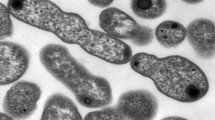Abstract
Pseudomonas (spp), isolated from a complex petrochemical sludge, was able to utilize 2-fluorobenzoate as its sole source of carbon and energy. At the end of the growth phase, about 42% of the organically bound fluoride was released. Catechol, 3-fluorocatechol, and 6-fluorodihydrodihydroxybenzoate were confirmed as intermediates by chromatographic and spectral analyses. During 2-fluorobenzoate metabolism, fluoride is eliminated before the aromaticity of the ring is lost. Twofold higher levels of catechol 1,2-oxygenase were detected in 2-fluorobenzoate-grown cells compared with cells grown on benzoate. When used as assay substrates, 3-chlorocatechol showed less catechol 1,2-oxygenase activity than catechol or 4-chlorocatechol. The ability to degrade 4-fluorobenzoate could be transferred toPseudomonas (spp) by the conjugal transfer of plasmid pWR1 fromPseudomonas sp. B13.
Similar content being viewed by others
Literature Cited
Bradford MM (1976) A rapid and sensitive method for the quantitation of microgram quantities of protein utilizing the principle of protein-dye binding. Anal Biochem 72:248–254
Clarke KF, Callely AG, Livingstone A, Fewson CA (1975) Metabolism of monofluorobenzoates byAcinetobacter calcoaceticus N.C.I.B. 8250. Biochim Biophys Acta 404:169–179
Dorn E, Knackmuss HJ (1978) Chemical structure and biodegradability of halogenated aromatic compounds. Two catechol 1,2-oxygenases from a 3-chlorobenzoate grown Pseudomonad. Biochem J 174:73–84
Engesser KW, Schmidt E, Knackmuss HJ (1980) Adaptation ofAlcaligenes eutrophus B9 andPseudomonas sp. strain B13 to 2-fluorobenzoate as growth substrate. Appl Environ Microbiol 39:68–73
Fewson CA (1981) Biodegradation of aromatics with industrial relevance. In: Leisinger T, Cook AM, Hütter R, Nüesch J (eds) Microbial degradation of xenobiotics and recalcitrant compounds. London: Academic Press, pp 141–179
Goldman P (1972) The use of microorganisms in the study of fluorinated compounds. In: A Ciba foundation symposium, carbon fluorine compounds, chemistry, biochemistry and biological activities. Amsterdam: Associated Scientific Publishers, pp 335–356
Goldman P, Milne GWA, Pignataro MT (1967) Fluorine containing metabolites from 2-fluorobenzoate byPseudomonas sp. Arch Biochem Biophys 118:178–184
Harder W (1981) Enrichment and characterization of degrading organisms. In: Leisinger T, Cook AM, Hütter R, Nüesch J (eds) Microbial degradation of xenobiotics and recalcitrant compounds. London: Academic Press, pp 77–96
Harper DB, Blakely ER (1971) The metabolism of p-fluorobenzoic acid byPseudomonas sp. Can J Microbiol 17:1015–1023
Johnson BF, Stainer RY (1971) Regulation of β-ketoadipate pathway. J Bacteriol 107:476–485
Kilbane JJ, Chatterjee DK, Kayns JS, Kellogg ST, Chakrabarty AM (1982) Biodegradation of 2,4,5-trichlorophenoxyacetic acid by a pure culture ofPseudmonas putida. Appl Environ Microbiol 44:72–78
Kobayash H, Rittman BE (1982) Microbial removal of hazardous organic compounds. Environ Sci Technol 16:170A-183A
Nozaki M (1970) Metapyrocatechase (Pseudomonas) In: Tabor H, Tabor CW (eds) Methods in enzymology, vol 17A. New York: Academic Press, pp 522–525
Reineke W, Knackmuss HJ (1979) Construction of haloaromatics utilising bacteria. Nature 277:385–386
Reineke W, Otting W, Knackmuss HJ (1978)cis-Dihydrodiols microbially produced from halo- and methylbenzoic acids. Tetrahedron 34:1707–1714
Reineke W, Wessels SW, Rubio MA, Latorre J, Schwien U, Schmidt E, Schlomann M, Knackmuss HJ (1982) Degradation of monochlorinated aromatics following transfer of genes encoding chlorocatechol catabolism. FEMS Microbiol Lett 14:291–294
Rothera ACH (1908) Note on sodium nitroprusside reaction for acetone. J Physiol 37:491–494
Schennen U, Braun K, Knackmuss HJ (1985) Anaerobic degradation of 2-fluorobenzoate by benzoate degrading denitrifying bacteria. J Bacteriol 161:321–325
Schreiber A, Hellwig M, Dorn E, Reineke W, Knackmuss HJ (1980) Critical reactions in fluorobenzoic acid degradation byPseudomonas sp. B13. Appl Environ Microbiol 39:58–67
Shailubhai K, Sahasrabudhe SR, Vora KA, Modi VV (1983) Degradation of chlorinated derivatives of phenoxyacetic acid and benzoic acid byA. niger. FEMS Microbiol Lett 18:279–282
Sistrom WR, Stainer RY (1954) The mechanism of formation of β-ketoadipic acid by bacteria. J Biol Chem 210:821–836
Author information
Authors and Affiliations
Rights and permissions
About this article
Cite this article
Vora, K.A., Singh, C. & Modi, V.V. Degradation of 2-fluorobenzoate by a pseudomonad. Current Microbiology 17, 249–254 (1988). https://doi.org/10.1007/BF01571323
Issue Date:
DOI: https://doi.org/10.1007/BF01571323




